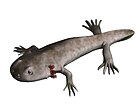Noonkanbah Station is a pastoral lease, both a cattle and sheep station, on the Fitzroy River between Camballin and Fitzroy Crossing in the south central Kimberley region of Western Australia.
Deltasaurus kimberleyensis was a temnospondyl amphibian of the family Rhytidosteidae that existed during the Carnian stage of the Triassic. The fossilised remains were discovered in the Blina Shale formation in the Kimberley region of northwest Australia in 1965.

Batrachosuchus is a genus of temnospondyl amphibian that existed from the Early to Middle Triassic of Southern Africa and the Blina Shale of Australia.

Deltasaurus is an extinct genus of Carnian temnospondyl amphibian of the family Rhytidosteidae.
Deltasaurus pustulatus is an amphibian fossil species of the family Rhytidosteidae. The temnospondyl hunted invertebrates and fish during the late stage Triassic epoch, and somewhat resembles the only other species of the eastern Gondwanan genus Deltasaurus. The only known evidence of the species was discovered in a drill core in Southwest Australia, near Geraldton, a seemingly improbable event that produced the only known example of Triassic vertebrate fauna in the ecologically exceptional region's Kockatea Formation.
Adelogyrinus is an extinct genus of prehistoric amphibian, fossils of which were found in the Dunnet Shale of Scotland.
Blinasaurus is a name of an extinct genus of prehistoric brachyopid found in Triassic geological formations of Australia. The type species is Platyceps wilkinsonii Stephens, 1887. The genus was established by John W. Cosgriff in 1969 to incorporate the type, discovered in New South Wales, and the author's new fossil species, Blinasaurus henwoodi, describing type material found in Blina Shale in the Kimberley region of northwest Australia.
Batrachosaurus is an extinct genus of prehistoric brachyopoid amphibian that lived in Germany during the Middle Triassic (Ladinian). The genus was named by Joseph Fitzinger in 1837 and the type species, B. jaegeri, was named three years later in 1840. It may have been the same animal as Mastodonsaurus.

Batrachiderpeton is an extinct genus of nectridean lepospondyl within the family Diplocaulidae; it was a basal member of the family. The type species is B. reticulatum and was found in a coal field in Northumberland, England at a locality that also yields the remains of Anthracosaurus russelli. A second species is also known: B. lineatum.
Chomatobatrachus is a genus of prehistoric temnospondyl from the Triassic.
Cosgriffius is an extinct genus of trematosaurian temnospondyl within the family Trematosauridae. It was described in 1993 by Samuel P. Welles based on a single partial skull from the well-known Meteor Crater Quarry in Arizona that also produced more abundant remains of the capitosaur Wellesaurus peabodyi. The skull was long and slender, features typically associated with the trematosaurid subfamily Lonchorhynchinae. This is the only trematosaurid known from western North America.
Notobrachyops is a genus of brachyopid temnospondyl amphibian. It is known from a skull roof impression found in the Ashfield Shale of Mortdale, New South Wales, Australia. The Ashfield Shale has also yielded a shark species, a lungfish species, six species of paleoniscid fish, a species of holostean fish, a subholostean fish, and the labyrinthodont amphibian Paracyclotosaurus davidi.
Rewana is an extinct genus of prehistoric temnospondyls. Two species have been described from the Arcadia Formation of Australia.
Vanastega is an extinct genus of Triassic temnospondyl amphibian in the family Brachyopidae. It is known from the Cynognathus Assemblage Zone in Burgersdorp, South Africa. The genus contains just one species, Vanastega plurimidens, the type species.

Platycepsion wilksoni is an extinct species of prehistoric amphibian, known from partial skeleton deposited in shale at the Gosford Quarry site of the Terrigal Formation in Australia.
Peltostega is an extinct genus of prehistoric trematosaurians. The type is the only known species, Peltostega erici It is known from the Early Triassic Kongressfjellet Formation of Svalbard and Jan Mayen.

Palaeomolgophis is an extinct genus of eel-like prehistoric amphibian containing a single species—Palaeomolgophis scoticus. Their limbs are much reduced, and they were probably were fully aquatic.
Thabanchuia is an extinct genus of dvinosaurian temnospondyl within the family Tupilakosauridae. It is known from the Lystrosaurus Assemblage Zone in Thaba N'chu, Free State, South Africa. The genus contains just one species, Thabanchuia oomie, the type species.

Subcyclotosaurus is an extinct genus of carnivorous prehistoric mastodonsaurid temnospondyl amphibian. It is known from a single partial skull from the Hawkesbury Sandstone formation in Australia.
Xenobrachyops is an extinct genus of temnospondyl amphibian from the Triassic of Australia, describing a single species, Xenobrachyops allos. It is estimated to have been around fifty centimetres long and its diet would have consisted of fish and insects.




















